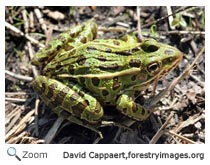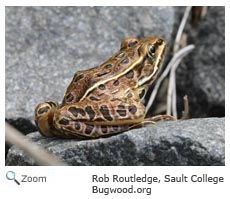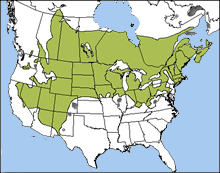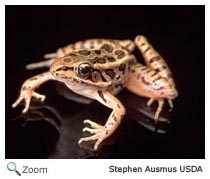Description
 The northern leopard frog is 2-4 inches in length and is green or greenish-brown. The female is larger than the male. It has oval-shaped, dark brown or green spots edged in a lighter color that look like the spots on a leopard. It has a white to greenish-white belly, a white stripe on its upper lip, and two light colored folds of skin called dorsolateral folds that run from the back of its eyes down along the sides of its back. The male has a pair of vocal sacs. The northern leopard frog is 2-4 inches in length and is green or greenish-brown. The female is larger than the male. It has oval-shaped, dark brown or green spots edged in a lighter color that look like the spots on a leopard. It has a white to greenish-white belly, a white stripe on its upper lip, and two light colored folds of skin called dorsolateral folds that run from the back of its eyes down along the sides of its back. The male has a pair of vocal sacs.
 The northern leopard frog is also known as the
meadow frog or grass frog.
The northern leopard frog is sometimes confused with the pickerel frog. The pickerel frog looks similar, but its spots are square and arranged in rows, and it has patches of bright yellow or orange skin on the inside of its thighs. The northern leopard frog is also known as the
meadow frog or grass frog.
The northern leopard frog is sometimes confused with the pickerel frog. The pickerel frog looks similar, but its spots are square and arranged in rows, and it has patches of bright yellow or orange skin on the inside of its thighs.
Range
 The northern leopard frog is found from
southern Canada across much of the northern United States, including New Hampshire. It is found in some scattered locations in the Pacific northwest, and it is also found in the southwest through Arizona and New Mexico.
The southern leopard frog, Lithobates sphenocephala, is similar in appearance to its northern cousin and is found in the southeastern United States. It has smaller spots and its head is more pointed. The northern leopard frog is found from
southern Canada across much of the northern United States, including New Hampshire. It is found in some scattered locations in the Pacific northwest, and it is also found in the southwest through Arizona and New Mexico.
The southern leopard frog, Lithobates sphenocephala, is similar in appearance to its northern cousin and is found in the southeastern United States. It has smaller spots and its head is more pointed. |
|
Habitat
The northern leopard frog is found near streams, ponds, lakes, meadows, fields, rivers, marshes, and other places with slow moving water and lots of vegetation. In the summer, they are often found in open grassy meadows, pastures, or fields, usually a fair distance from the water.
Diet
 The northern leopard frog is an opportunistic feeder. That means it eats just about anything that it can fit into its mouth! It eats insects like beetles, ants, and leafhoppers. It also eats pillbugs, slugs, snails, and even smaller frogs. It has been known to eat small birds and snakes! It often waits in grassy meadows, fields, or at the edge of the water for its prey. It stalks its prey; leaps after it; and snatches it up with its long, sticky tongue! Tadpoles eat algae and rotting plants. The northern leopard frog is an opportunistic feeder. That means it eats just about anything that it can fit into its mouth! It eats insects like beetles, ants, and leafhoppers. It also eats pillbugs, slugs, snails, and even smaller frogs. It has been known to eat small birds and snakes! It often waits in grassy meadows, fields, or at the edge of the water for its prey. It stalks its prey; leaps after it; and snatches it up with its long, sticky tongue! Tadpoles eat algae and rotting plants.
Life Cycle
 Breeding season runs from March to June. Males gather in breeding pools on warm sunny days and float on the top of the water and call out with a low grunting snore-like sound to attract females.
The female lays a mass of as many as 5,000 eggs in still, warm, shallow water. The eggs are usually attached to vegetation and hatch in about 9 days. The tadpoles begin to change into frogs in the late summer. The northern leopard frog hibernates in the mud of pond and stream bottoms in the winter. They hibernate in water that will not completely freeze over in the winter. Breeding season runs from March to June. Males gather in breeding pools on warm sunny days and float on the top of the water and call out with a low grunting snore-like sound to attract females.
The female lays a mass of as many as 5,000 eggs in still, warm, shallow water. The eggs are usually attached to vegetation and hatch in about 9 days. The tadpoles begin to change into frogs in the late summer. The northern leopard frog hibernates in the mud of pond and stream bottoms in the winter. They hibernate in water that will not completely freeze over in the winter.
Behavior
The northern leopard frog sometimes lets out a screaming call when it is captured or startled.
|




 The northern leopard frog is found from
southern Canada across much of the northern United States, including New Hampshire. It is found in some scattered locations in the Pacific northwest, and it is also found in the southwest through Arizona and New Mexico.
The southern leopard frog, Lithobates sphenocephala, is similar in appearance to its northern cousin and is found in the southeastern United States. It has smaller spots and its head is more pointed.
The northern leopard frog is found from
southern Canada across much of the northern United States, including New Hampshire. It is found in some scattered locations in the Pacific northwest, and it is also found in the southwest through Arizona and New Mexico.
The southern leopard frog, Lithobates sphenocephala, is similar in appearance to its northern cousin and is found in the southeastern United States. It has smaller spots and its head is more pointed.
